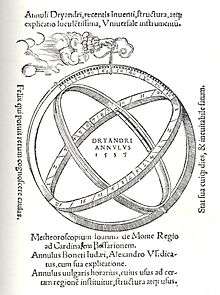Astronomical rings
Astronomical rings (Latin: annuli astronomici),[1] also known as Gemma's rings, are an early astronomical instrument. The instrument consists of three rings, the meridian, the equator, and the declination ring. It may be considered to be a simplified, portable armillary sphere, or a more complex form of astrolabe.

Gemma Frisius was the designer of the astronomical rings in the 16th century. He was known as a physician, mathematician, cartographer, philosopher, and instrument maker. He created important globes, improved the mathematical instruments of his day and applied mathematics in new ways to surveying and navigation.
The Rings
These three rings are self-orienting. When the shadow of the rings are aligned so that they appear to be in the same, or nearly the same, place, the meridian identifies itself.
Meridian
The meridian ring, when in use, occupies a plane with one axis running north and south, and the other vertical. A sliding suspension shackle is attached to the top of this ring, from which the whole device can be suspended. When properly used, this points to the latitude at which the instrument is being used. This ring can function as the gnomon, when the rings are used as a sundial.
A horizontal line aligned on a meridian with a gnomon facing the noon-sun is termed a meridian line and does not indicate the time, but instead the day of the year. Historically they were used to accurately determine the length of the solar year.
On some forms of the astronomical rings, the meridian ring is engraved with arcs measuring 0-90 degrees on a latitude scale. At every 10 degrees there is the corresponding numeral printed along with a long has mark which is divided into even smaller units of measurement for a more accurate reading. A slightly smaller hash mark can be found at every half of the 10 degrees and even smaller hash marks note each degree.[2] This allows for the measurement of the sun's height.[3]
Equatorial
The equatorial ring occupies a plane parallel to the celestial equator, at right angles to the meridian. Often equipped with a graduated scale, it can be used to measure right ascension.
This ring is sometimes engraved with the months on one side and corresponding zodiac signs on the outside; very similar to an astrolabe. Others have been found to be engraved with two twelve-hour time scales. Each twelve-hour scale is stretched over 180 degrees and numbered by hour with hashes every 20 minutes and smaller hashes every four minutes. The inside displays a calendrical scale with the names of the months indicated by their first letters, with a mark to show every 5 days and other marks to represent single days. On these, the outside of the ring is engraved with the corresponding symbols of the zodiac signs. The position of the symbol indicates the date of the entry of the sun into this particular sign. The vernal equinox is marked at March 15 and the autumnal equinox is marked at September 10.[4]
Declination
The declination ring is moveable, and rotates on pivots set in the meridian ring. An imaginary line connecting these pivots is parallel to the Earth's axis. This ring is often equipped with vanes and pinholes for use as the alidade of a dioptra. It can be used to measure declination.
This ring is also marked with the zodiac signs and twenty-five stars, similar to the astrolabe.
History
The parts of the instrument go back to instruments made and used by ancient Greek astronomers. Gemma Frisius combined several of the instruments into a small, portable instrument, first published in 1534,[5] and in Petrus Apianus's Cosmographia in 1539.
Uses
This instrument can be used as a sun dial to tell time.
References
- ↑ "Annulus Astronomicus". Retrieved 2009-07-18.
- ↑ https://www.britishmuseum.org/research/collection_online/collection_object_details/collection_image_gallery.aspx?partid=1&assetid=494614&objectid=55055 Retrieved 2013-11-10
- ↑ http://www.gilai.com/product_848/Mid-18th-Century-Brass-Astronomical-ring-dial.
- ↑ https://www.britishmuseum.org/research/collection_online/collection_object_details.aspx?objectId=55055&partId=1
- ↑ Sorgeloos, Claude (2001). "Un post-incunable retrouvé : L'Usus annuli astronomici de Gemma Frisius, Louvain et Anvers, 1534" [A post-incunabula discovery: 'The use of astronomical rings' by Gemma Frisius]. Quaerendo (in French). Leiden. 31 (4): 255–264. doi:10.1163/157006901X00155. ISSN 0014-9527. Retrieved 2009-07-19.
Bibliography
- Frisius, Gemma (1548). Usus annuli astronomici [The Use of the Astronomical Rings] (digital reprint) (in Latin). Antwerp. OCLC 166113158. Retrieved 2009-07-17.